让我们使用 W5500-evb-pico 进行唤醒词检测。
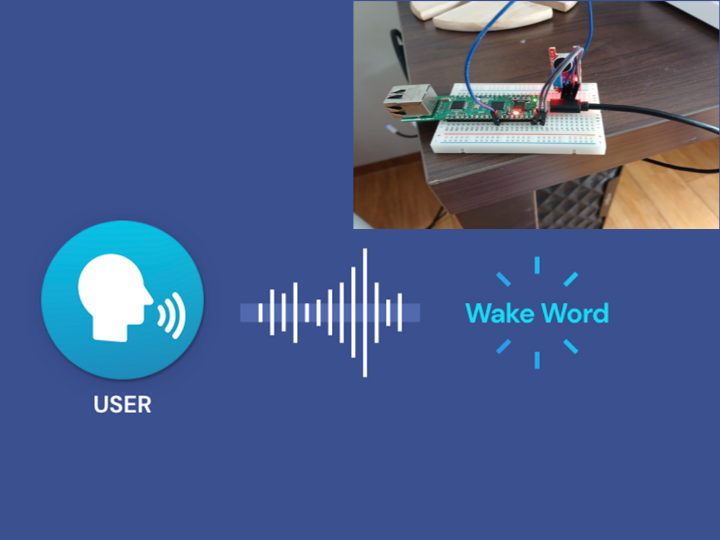
转发: TinyML - WakeWord Detection
项目介绍
概括
这篇文章讨论了语音识别系统。 它涵盖了语音识别的原理,包括傅里叶变换和 STFT(短时傅里叶变换)。 它提供了使用 Arduino 和 Python 收集和预处理语音数据、训练模型以及使用 TensorFlow Lite 转换模型的代码示例。 详细解释了系统架构和操作,以及使用 Arduino 和 Python 代码的实现步骤。
概述
为了更好地了解资源有限的物联网设备中唤醒词检测的底层技术,我们将对远不如 iPhone 等功能强大的 Arduino 进行研究。
我们将使用现有数据集,使用 Tensorflow 训练我们的模型,将其转换为 TensorFlow Lite 模型并将模型部署到 Arduino 中。 然后我们通过Arduino IDE消息来获取输出信息。
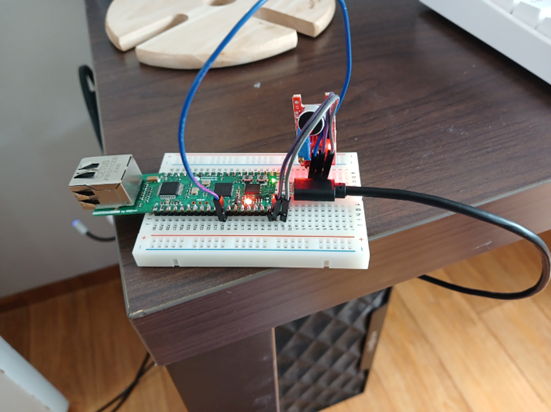
先验知识
语音识别原理-声音

声源用以下波形绘制。
从声源本身提取特征值是很困难的,并且由于特征值的数量呈指数增长,因此不可能仅从传感器值中提取特征。
傅里叶变换和频谱图

- 对声源进行傅立叶变换,将[时间轴]的波形变为[频率轴]的波形。
可以提取增益大的频率下的特性。
-然而,由于语音具有时间特征,因此仅根据频率特征很难对其进行分类。
- 例如,如果只看频率特性,则无法区分“Banana”和“naBana”。
STFT(短时傅立叶变换)
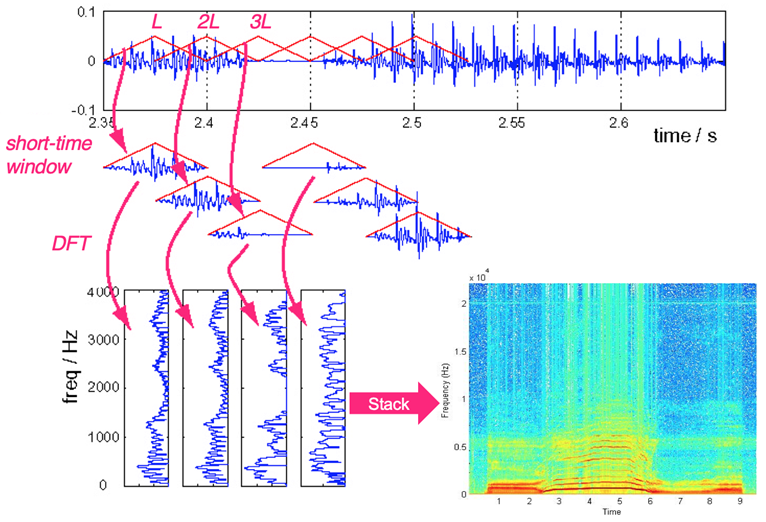
-通过将声源的时间分成短段来尝试傅里叶变换
-逆时针旋转傅立叶变换图的累加形式称为STFT。
- 频率范围的大小表示为 0 到 255 之间的值。
- 在此代码中,我们尝试通过转换为 (257X4) 张量进行傅里叶变换。
系统图

在 PC 上将数据集转换为频谱图并对其进行训练。
它使用 CNN 进行学习,并将学习到的数据转换为 TFLite 并二进制化为 .cpp 以适合 Arduino 模型。
然后,Arduino 加载模型并将传感器值注入模型中以进行推理。
代码
Get_sounds.ino
#include <fix_fft.h>
const int analogSensorPin = 26;
const int ledPin = LED_BUILTIN;
const int sampleRate = 1000;
const int sampleTime = 1;
const int totalSamples = sampleRate * sampleTime;
int16_t vReal[totalSamples];
int16_t vImag[totalSamples];
unsigned long startTime;
void fft_wrapper(int16_t* vReal, int16_t* vImag, int n, int inverse) {
fix_fft((char*)vReal, (char*)vImag, n, inverse);
}
void setup() {
Serial.begin(9600);
pinMode(ledPin, OUTPUT);
}
void loop() {
//Serial.print("fft calculate");
digitalWrite(ledPin, HIGH);
startTime = millis();
for (int i = 0; i < totalSamples; i++) {
vReal[i] = analogRead(analogSensorPin);
vImag[i] = 0; // 허수부는 0으로 초기화
while (millis() < startTime + (i * 1000.0 / sampleRate));
}
digitalWrite(ledPin, LOW);
// FFT 계산
fft_wrapper(vReal, vImag, 10, 0);
// FFT 결과 출력
for (int i = 0; i < totalSamples / 2; i++) {
double frequency = (i * 1.0 * sampleRate) / totalSamples;
double magnitude = sqrt(vReal[i] * vReal[i] + vImag[i] * vImag[i]);
//Serial.print(frequency);
//Serial.print(",");
Serial.println(magnitude);
}
delay(2000);
}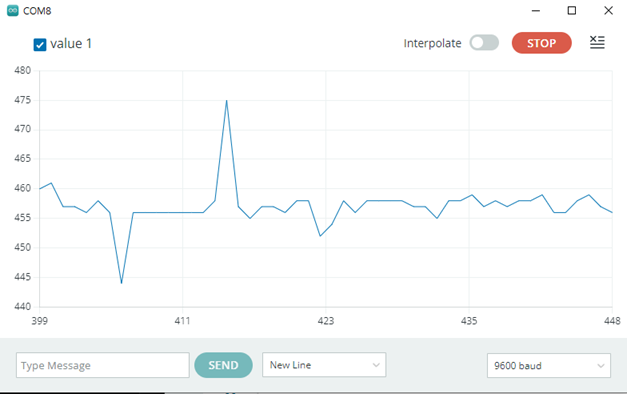
get_voice_data.py
import serial
import numpy as np
import librosa
import csv
# 아두이노에서 데이터 읽어오기
ser = serial.Serial('COM13', 9600)
sampleRate = 1000
sampleTime = 1
totalSamples = sampleRate * sampleTime
while True:
try:
data = []
while len(data) < totalSamples:
if ser.in_waiting:
value = ser.readline().decode().strip()
if value:
data.append(float(value))
# 데이터 전처리
data = np.array(data)
data = data / 1023.0 # 정규화
# 오디오 데이터 변환
sr = sampleRate # 샘플링 레이트
audio = librosa.resample(data, orig_sr=sr, target_sr=sr) # 리샘플링
stft = librosa.stft(audio, n_fft=512, hop_length=256) # STFT 적용
spectrogram = librosa.amplitude_to_db(np.abs(stft), ref=np.max) # 스펙트로그램 변환
# 스펙트로그램 데이터를 CSV 파일로 저장
with open('you.csv', 'a', newline='') as csvfile:
writer = csv.writer(csvfile)
writer.writerows(spectrogram)
except KeyboardInterrupt:
break
ser.close()
没有什么
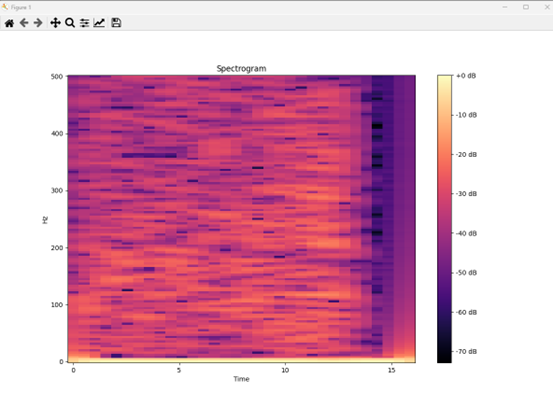
噪音
Train_voice_data.ipynb
import numpy as np
import pandas as pd
import tensorflow as tf
from sklearn.model_selection import train_test_split
# CSV 파일 읽어오기
nothing_data = pd.read_csv('nothing.csv', header=None)
wiznet_data = pd.read_csv('wiznet.csv', header=None)
you_data = pd.read_csv('you.csv', header=None)
# 데이터 병합 및 레이블 할당
data = np.vstack((nothing_data, wiznet_data, you_data))
labels = np.concatenate((np.zeros(len(nothing_data)), np.ones(len(wiznet_data)), np.ones(len(you_data))*2))
# 학습 데이터와 테스트 데이터 분리
X_train, X_test, y_train, y_test = train_test_split(data, labels, test_size=0.2, random_state=42)
# 입력 데이터 크기 확인
input_shape = X_train.shape[1]
# 모델 구성
model = tf.keras.Sequential([
tf.keras.layers.Dense(128, activation='relu', input_shape=(input_shape,)),
tf.keras.layers.Dense(64, activation='relu'),
tf.keras.layers.Dense(3, activation='softmax')
])
# 모델 컴파일
model.compile(optimizer='adam',
loss='sparse_categorical_crossentropy',
metrics=['accuracy'])
# 모델 학습
model.fit(X_train, y_train, epochs=50, batch_size=32, validation_data=(X_test, y_test))
# 모델 평가
test_loss, test_acc = model.evaluate(X_test, y_test)
print('Test accuracy:', test_acc)
# TensorFlow Lite 변환
converter = tf.lite.TFLiteConverter.from_keras_model(model)
tflite_model = converter.convert()
# TensorFlow Lite 모델 저장
with open('voice_recognition_model.tflite', 'wb') as f:
f.write(tflite_model)
def representative_dataset_gen():
for i in range(len(X_train)):
yield [X_train[i].astype(np.float32)]
# TensorFlow Lite 변환 및 완전 정수 양자화
converter = tf.lite.TFLiteConverter.from_keras_model(model)
converter.optimizations = [tf.lite.Optimize.DEFAULT]
converter.representative_dataset = representative_dataset_gen
converter.target_spec.supported_ops = [tf.lite.OpsSet.TFLITE_BUILTINS_INT8]
converter.inference_input_type = tf.int8
converter.inference_output_type = tf.int8
tflite_quant_model = converter.convert()
# 완전 정수 양자화된 TensorFlow Lite 모델 저장
with open('voice_recognition_model_quant.tflite', 'wb') as f:
f.write(tflite_quant_model)
这就是训练的结果。
因为数据集本身并不充足,所以表现出不稳定的学习情况。 在丢失的情况下,准确性会因突然激增而降低,但总体上似乎是在学习。
考虑到分类分为三种且数据不足,我对比预期更高的准确率感到满意。
WakeWord_Detection.ino
#include <TensorFlowLite.h>
#define ARDUINO_EXCLUDE_CODE
#include "tensorflow/lite/micro/kernels/all_ops_resolver.h"
#include "tensorflow/lite/micro/micro_error_reporter.h"
#include "tensorflow/lite/micro/micro_interpreter.h"
#include "tensorflow/lite/schema/schema_generated.h"
#include "tensorflow/lite/version.h"
#undef ARDUINO_EXCLUDE_CODE
#include "voice_recognition_model.h" // 변환된 모델 파일 포함
#include <fix_fft.h>
// 모델 관련 상수 정의
const int kTensorArenaSize = 4 * 1024; // 텐서 아레나 크기 증가
const int kNumInputs = 1;
const int kNumOutputs = 1;
const int kInputFrames = 4;
const int kInputShape[4] = {1, 257, kInputFrames, 1};
const int kOutputSize = 3;
const int analogSensorPin = 26;
const int ledPin = LED_BUILTIN;
const int sampleRate = 1000;
const int sampleTime = 1;
const int totalSamples = sampleRate * sampleTime;
int16_t vReal[totalSamples];
int16_t vImag[totalSamples];
unsigned long startTime;
// 텐서 아레나 메모리 할당
uint8_t tensor_arena[kTensorArenaSize];
// 오디오 입력 버퍼
float audio_buffer[257 * kInputFrames];
int audio_buffer_index = 0;
// 모델 추론 함수
String inference(float* input_data) {
// 에러 리포터 설정
tflite::MicroErrorReporter micro_error_reporter;
tflite::ErrorReporter* error_reporter = µ_error_reporter;
// 플랫버퍼 모델 포인터 설정
const tflite::Model* model = ::tflite::GetModel(voice_recognition_model_tflite);
if (model->version() != TFLITE_SCHEMA_VERSION) {
return "Model schema mismatch";
}
// 모델 연산자 설정
tflite::ops::micro::AllOpsResolver resolver;
// 인터프리터 생성
tflite::MicroInterpreter interpreter(model, resolver, tensor_arena, kTensorArenaSize, error_reporter);
// 텐서 할당
interpreter.AllocateTensors();
// 입력 텐서 포인터 얻기
TfLiteTensor* input = interpreter.input(0);
// 입력 데이터 복사
for (int i = 0; i < 257 * kInputFrames; i++) {
input->data.f[i] = input_data[i];
}
// 추론 실행
TfLiteStatus invoke_status = interpreter.Invoke();
if (invoke_status != kTfLiteOk) {
return "Invoke failed";
}
// 출력 텐서 포인터 얻기
TfLiteTensor* output = interpreter.output(0);
// 출력 결과 처리
int predicted_class = 0;
float max_probability = output->data.f[0];
for (int i = 1; i < kOutputSize; i++) {
if (output->data.f[i] > max_probability) {
predicted_class = i;
max_probability = output->data.f[i];
}
}
// 결과 반환
if (predicted_class == 0) {
return "Nothing";
} else if (predicted_class == 1) {
return "WIZnet";
} else if (predicted_class == 2) {
return "You";
}
return "Unknown";
}
void fft_wrapper(int16_t* vReal, int16_t* vImag, int n, int inverse) {
fix_fft((char*)vReal, (char*)vImag, n, inverse);
}
void setup() {
// 시리얼 통신 초기화
Serial.begin(9600);
pinMode(ledPin, OUTPUT);
}
void loop() {
Serial.print("PLEASE Recognized word: ");
// 오디오 입력 받기
if (audio_buffer_index < 257 * kInputFrames) {
digitalWrite(ledPin, HIGH);
startTime = millis();
for (int i = 0; i < totalSamples; i++) {
vReal[i] = analogRead(analogSensorPin);
vImag[i] = 0; // 허수부는 0으로 초기화
while (millis() < startTime + (i * 1000.0 / sampleRate));
}
digitalWrite(ledPin, LOW);
// FFT 계산
fft_wrapper(vReal, vImag, 10, 0);
// FFT 결과를 audio_buffer에 저장
for (int i = 0; i < totalSamples / 2; i++) {
double magnitude = sqrt(vReal[i] * vReal[i] + vImag[i] * vImag[i]);
audio_buffer[audio_buffer_index++] = magnitude;
}
}
// 오디오 버퍼가 가득 찼을 때 추론 수행
if (audio_buffer_index >= 257 * kInputFrames) {
// 추론 실행
String result = inference(audio_buffer);
// 결과 출력
Serial.print("Recognized word: ");
Serial.println(result);
// 오디오 버퍼 초기화
audio_buffer_index = 0;
}
delay(500); // 500밀리초 대기
}




















 1159
1159











 被折叠的 条评论
为什么被折叠?
被折叠的 条评论
为什么被折叠?








